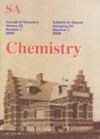Degradation of o-Chloranil Using Nanocrystalline-Cellulose/TiO2 Composites via a Solar Photocatalytic Route
IF 1
4区 化学
Q4 CHEMISTRY, MULTIDISCIPLINARY
South African Journal of Chemistry-Suid-Afrikaanse Tydskrif Vir Chemie
Pub Date : 2021-01-01
DOI:10.17159/0379-4350/2021/V75A10
引用次数: 1
Abstract
ABSTRACT Water pollution by organic pollutants is a continuous and increasing problem of global concern. In this paper, we developed a nanocrystalline cellulose (NCC) and titania (TiO2) based nanocomposite for the photocatalytic degradation of o-chloranil via aqueous wet impregnation. Different NCC loadings (10, 20, 40, and 80%) were used, and several analytical and microscopy techniques characterised the NCC/TiO2 catalyst. The efficiency of TiO2 as a photo-catalyst was enhanced through the chiral nematic nature and potential charge carrier capacity of NCC, which lowered the rate of electron recombination. The NCC/TiO2 material was used in the solar-driven photo-degradation of o-chloranil (3,4,5,6-tetrachloro-1,2-benzoquinone), a by-product of a commonly used pesticide. The successful decomposition of o-chloranil led to the successful identification of three breakdown products, namely 2,3-dichloro-4,5-dioxohex-2-enedoic acid (DCA), 2,3-dioxosuccinic acid (DSA) and oxalic acid (OA). The 20% NCC/TiO2 catalyst was found to be optimum and showed excellent degradation and mineralisation of o-chloranil within 2 hours (~90% degradation after 2 hours or 0.00920 mols of the total 0.0102 mols). The degradation products were analysed and identified using GC-MS. The photo-catalyst offers many benefits, including ease of preparation, a low cost-factor, and high stability with no loss of activity. Keywords: nanocrystalline cellulose; o-chloroanil; photocatalyst; photo-degradation; titania纳米晶纤维素/TiO2复合材料在太阳光催化下降解邻氯胺
有机污染物对水体的污染是一个持续且日益受到全球关注的问题。在本文中,我们开发了一种基于纳米纤维素(NCC)和二氧化钛(TiO2)的纳米复合材料,用于水湿浸渍光催化降解邻氯胺。使用了不同的NCC负载(10,20,40和80%),并使用了几种分析和显微镜技术表征了NCC/TiO2催化剂。通过NCC的手性向列相性质和潜在的电荷载流子容量,TiO2作为光催化剂的效率得到了提高,从而降低了电子复合的速率。NCC/TiO2材料用于太阳能光降解一种常用农药的副产物邻氯胺(3,4,5,6-四氯-1,2-苯醌)。邻氯胺的成功分解导致三种分解产物的成功鉴定,即2,3-二氯-4,5-二氧己二烯酸(DCA)、2,3-二氧琥珀酸(DSA)和草酸(OA)。结果表明,20%的NCC/TiO2催化剂在2小时内对邻氯胺具有良好的降解和矿化效果(2小时后降解约90%,占0.0102 mol的0.00920 mol)。采用GC-MS对降解产物进行了分析和鉴定。光催化剂具有许多优点,包括易于制备,成本低,稳定性高且不损失活性。关键词:纳米纤维素;o-chloroanil;光催化剂;;降解;提泰妮娅
本文章由计算机程序翻译,如有差异,请以英文原文为准。
求助全文
约1分钟内获得全文
求助全文
来源期刊
CiteScore
3.10
自引率
0.00%
发文量
6
审稿时长
>12 weeks
期刊介绍:
Original work in all branches of chemistry is published in the South African Journal of Chemistry. Contributions in English may take the form of papers, short communications, or critical reviews.

 求助内容:
求助内容: 应助结果提醒方式:
应助结果提醒方式:


